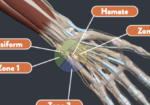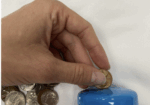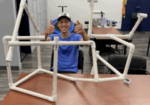New Distal Bicep Tendinopathy Provocative Test for Hand Therapist
Filed under Evaluation
Caekebeke, P., Schenkels, E., Bell, S. N., & van Riet, R. (2021). Distal biceps provocation test. The Journal of Hand Surgery.
The Skinny:
These surgeons were looking for a provocative test for distal bicep tendinopathy (distal biceps tendonitis test), specifically partial tears, that was more sensitive and specific. Complete tears are more easily tested in the clinic, but more precise tests are needed for partial tears before MRI use is warranted. This study investigated the merits of the Bicep Provocative Test (BPT).
In The Weeds:
The BPT is conducted with the patient’s arm flexed at 70 degrees. Step one is isometric flexion against resistance in supination. Step 2 (BPTp) is the same stimulus with the forearm in pronation. The pronated position is postulated to create more pain response with this test, given that the distal bicep tendon’s attachment to the radial tuberosity results in different mechanics in supination versus pronation.
“The distal biceps tendon wraps around the radial tuberosity when the arm is pronated, and the tendon is stretched and compressed when the biceps is activated”
The BPT was conducted on 60 individuals in a double-blind manner. Thirty individuals had suspected distal bicep pathology and 30 patients with other pathology of the elbow. Results of the provocative test were confirmed with MRI or from surgical findings.
Taking it Home:
The BPT produced a sensitivity and specificity of 100% each. The pronation position produced increased pain versus the supinated position by 5-6 points on the visual analog scale (0-10). This suggests that the pronated position might be more sensitive on a larger sample size. This provides therapists with a clinic-based provocative test to direct care or outside referral for partial distal bicep tendon pathology.
Rating: 4/5
The sample size for this study was relatively small at 60 participants, and the sensitivity and specificity would almost certainly be less than 100% with more participants. Overall, however, this is a well-written article that introduces a new provocative test that clarifies the identification of an otherwise difficult to diagnose pathology.
3 Comments
Leave a Comment
More To Read
Handlebar Palsy also known as Ulnar Nerve Compression
Handlebar Palsy also known as Ulnar Nerve Compression Handlebar palsy, also known as ulnar nerve compression, is a condition commonly experienced by cyclists due to prolonged pressure on the ulnar nerve at the wrist in an area called Guyon’s Canal. This pressure can occur from putting pressure on the handlebars or gripping the handlebars tightly. …
Read More3 Household Objects for 9 different Hand Therapy Activities
Do you struggle to develop new treatment ideas or even ideas for your virtual hand therapy visits? Thinking of unique ways to use objects your clients have in their homes can be half the battle. This blog post presents 3 different ways to use 3 everyday items. Item number 1: A tennis ball (hand therapy…
Read MoreVagus Nerve Stimulation (VNS) for Various Etiologies
What is it: Vagus nerve stimulation (VNS) is a medical treatment that uses a device to deliver electrical impulses to the vagus nerve, which runs on both sides of the body from the lower brain through the neck to the chest and stomach. The left vagus nerve is typically used for this procedure, as simulating…
Read MoreOccupation Based Interventions in Hand Therapy
Keeping Occupation Based Interventions in Hand Therapy By: Tristany Hightower Are your treatments occupation based? Do you tailor your activity choices to fit the needs of each patient? As occupational therapists, we should be specialists in creating goals and interventions that are directed at returning our patients to meaningful occupations. Too often, hand therapy can…
Read MoreSign-up to Get Updates Straight to Your Inbox!
Sign up with us and we will send you regular blog posts on everything hand therapy, notices every time we upload new videos and tutorials, along with handout, protocols, and other useful information.







Thank you for this concise review! You and Josh are great and appreciated!
Thank you, Cece! So great to hear from you.
What are your recommendations for treatment of partial distal bicep tendon tears? Thank you very much.